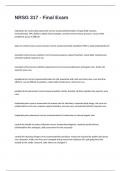NRSG 317 - Final Exam
indications for central line placement correct answersadministration of large fluid volumes,
chemotherapy, TPN, ability to obtain blood samples, monitor central venous pressure, access when
peripheral access is difficult
types of central venous access devices correct answerstunneled, peripheral (PICC), subq (implanted) port
tunneled central venous catheter correct answersrequires surgical insertion, needs daily maintenance,
restricted activity, long term use
tunneled central venous catheters placement correct answerssubclavian and jugular vein, feeds into
superior vena cava
peripheral line correct answerseliminates the risk associated with neck and chest area, cost and time
efficient, can be difficult to position, needs daily maintenance, short term use
peripheral line placement correct answerscephalic, basilic, brachial, tip then empties into superior vena
cava
implanted ports correct answershas the lowest rate for infections, improved body image, site care not
needed when not in use, requires surgical insertion, increase cost, unrestricted activity, long term use
implanted ports placement correct answersinserted in subclavian or internal jugular vein
central line bundle to reduce infection correct answershand hygiene, maximal sterile barriers,
chlorhexidine skin antisepsis, daily assessment for line necessity
central line dressing change correct answerssterile procedure, masks are required for patient and nurse,
use a biopatch, make sure lines aren't tangled and go away from injection site, pull going from the
outside to the inside, measure, date when you changed it
, central line dressing change timeline correct answerschange transparent dressings every 7 days and
gauze dressing every 2 days
central line flushing procedure correct answersfollow hospital protocol, use the SASH method, use a 10
mL syringe to generate lower injection pressure to prevent rupture of the catheter, use push-pause
method when indicated
SASH method correct answerssaline -> administer meds -> saline -> heparin
push-pause method correct answersplunging, causes turbulence in the catheter and flushes out blood
and drug more effectively, prevents blood or fibrin adherence to the lumen wall and tip
central line complicatons correct answersCLABSI, perforation, occlusion, accidental removal of catheter
infection correct answerslocal: erythema, tenderness, exudate
systemic: fever, chills, n/v, malaise
thrombosis correct answerswith PICC lines, measure for subclavian thrombosis, measure arm
circumference to see if it gets larger
ostomy correct answerssurgical procedure performed to bypass or removed injured or diseased bowel,
manage medical conditions
types of ostomies correct answersileostomy, ascending colostomy, transverse colostomy, descending or
sigmoid colostomy, incontinent urinary diversion, continent urinary diversion
ostomy supplies correct answersskin barrier: adhesive portion that is immediately around the stoma,
protects the stoma and holds the pouching system in place
pouch: bag that collects output from the stoma




